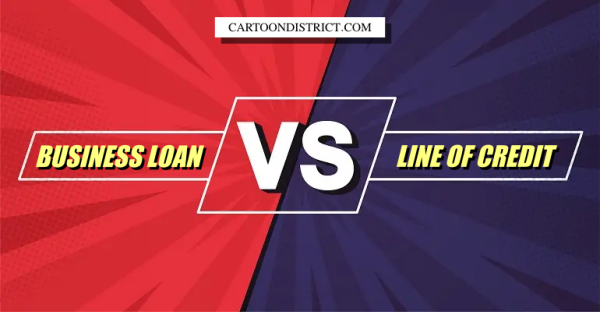Business loans can help you provide a wider range of options for maintaining or upgrading your business. Today various different loan types are available for small businesses, these include traditional bank loans, Small Business Administration (SBA) loans, online loans, etc.

Each loan type offers specific terms and conditions. Some lenders offer loans with better terms or interest rates than their rivals. Finding a good offer can be challenging, it requires extensive research on each loan type and its available lenders.
Why a business loan?

Business loans compared to credit lines are offered by more lenders. This means going with a traditional business loan can allow you to choose from far more options. Business loans have their own set of advantages and disadvantages and are not suited to everyone’s needs. But once you go over this article, you will get a better idea of which case business loan is the better option.
But before comparing the two most important aspects of a financing option: credit amount and interest, let’s check out something else.
The 3 most commonly used loan types

Traditional Term Loans
This type of business loan is most frequently used. The lender gives you lump money, which you repay on a predetermined timetable in regular installments. The majority of these loans demand security or collateral.
Loans from the Small Business Administration (SBA)
The SBA provides loan guarantees for small to medium enterprises. For instance, the SBA might propose to pay back 85% of your loan, subject to a cap.
Unsecured business loans
Operate similarly to typical term loans, with the exception that you are not needed to put up collateral in order to be approved for funding. These loans usually feature tougher credit score criteria and higher interest rates.
Now let’s move on to the comparison:
Credit amount
Larger borrowing levels are often available with business loans. The loan amount range for business loans can be between $500 to $5,000,000. With business loans, you can also take out a loan for less amount of money and repay it in a period of 6 to 24 months. This can be the smart choice if you have unexpected expenses and need funds to get through a crisis or tough period.

If you want to buy or upgrade your equipment or build a new warehouse, where a large number of funds will be needed, you can apply for a long-term loan with a longer return term. Some commercial loans have long terms of up to 30 years.
Credit lines on the other hand offer smaller sums. Because they intend to have shorter terms the credit limit is significantly lower. This means if you need a larger sum of money you probably are better of with a traditional business loan.
Interest rate
Low-interest rates are typical for business loans. The terms of business loans are structured explicitly as well. For instance, you are fully aware of the amount of interest you must pay and the due dates for your payments. Additionally, these installments are planned so that you can predict your financial flow with ease.

A line of credit is more flexible than business loans, but the unplanned nature of repayments makes it difficult to anticipate the interest rate. Calculating interest becomes more difficult because you can withdraw money at any time from your credit line which can change the previous interest rate. A lot of LOC lenders also add on maintenance costs and other commitment fees that are not previously planned. Therefore, make sure you comprehend the terms of your LOC and the interest rate before signing the contract. And most importantly, make sure to read the small print and look for any possible hidden costs.
Final words
These two factors will give you the foundation to start looking for the right financing option for your business. A lot of other factors should be considered in the further process, so make sure you are fully informed before you make any decision.
